Proteins, which are of vital importance to the survival of living things, are produced by a flawless organization in the cell, whose complexity and regularity cannot be compared with any other production system.
In this complex system, there is no room for the slightest error. A flaw arising at any stage is corrected immediately, due to a reliable control system. In this way the proteins that permit the living organism to survive are manufactured in exactly the right forms and locations, with no disruptions arising.
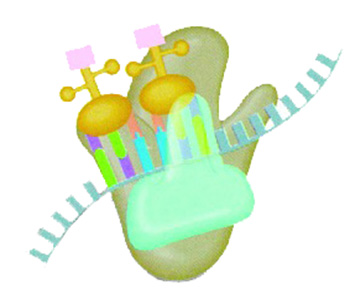 |
Protein production takes place at a miraculous speed. For example, the E. coli bacterium synthesizes a protein molecule bearing 100 amino acids in only 5 seconds. No factory on Earth is able to complete a flawless production process so rapidly. This speed is of great importance, because for life to be maintained, the cells need new proteins every moment. 17
During protein production, a great many proteins act together. All the components necessary for protein production work flawlessly together in the cells. More than 80 ribosome proteins, more than 20 amino acid messenger molecules, more than a dozen helper enzymes, over 40 RNA molecules, and more than 100 enzymes that carry out the final processes,—a total of around 300 macromolecules—play a coordinated role in protein synthesis.18 This flawless production, which even a team of engineers would have trouble coordinating, maintains life in a space just 1,000th of a millimeter in size, through the actions of hundreds of much smaller molecules. In the event that a single one of those molecules fails, the entire production chain is ruined. This indicates that protein production is one of the irreducibly complex processes in living things. In an irreducibly complex system, if only one of its components is removed, then the entire structure is ruined. For example, if only one protein fails to emerge, that puts an end to production of new proteins. The existence of such a planned and communal consciousness is possible only by Allah's creation.
In the pages following, you can read some astonishing details in this miracle of creation, whose every stage embodies great information and conscious organization. But first, let us remind you that the production elements you'll be reading about are organelles and molecules inside the cell. When we examine these molecules' structure, amino acids emerge—smaller molecules in other words—and the unconscious, inanimate atoms that comprise them. With an intellect and consciousness one would never expect from them, these combinations of atoms such as carbon, oxygen and nitrogen carry out processes far beyond the capacities of human beings.
But what makes unconscious atoms carry out conscious actions? What makes these atoms more efficient than chemistry professors? This achievement, to be explained out in the following pages, is due to inanimate atoms and unconscious molecules behaving under the Might of Allah, Who regulates all things from Heavens to Earth.
Whenever the body needs any protein, a message expressing that need is transmitted to the DNA molecule in the nucleus of cells that will carry out that protein's production. Whenever need for any protein arises in the body, various messenger proteins can locate the exact location where they have to go inside the darkness of the body and can transmit the message to the exact correct place and in the right form. The protein that establishes that communication reaches its location without becoming lost and without causing any harm to any part of the body. Clearly every component shows a great awareness of its responsibilities.
When the message arrives, the cell nucleus creates protein following a series of most complex and organized processes. The protein request reaches the correct cells among the 100 trillion or so in the body. The cells receiving the message understand what is required and immediately go to work. Eventually, a flawless protein is obtained— all astonishing phenomena, because we are discussing not a community of conscious, intelligent human beings possessed of free will, but rather minute entities consisting of such substances as phosphorus, carbon and fat. These molecules themselves do not possess the power and free will. Like all molecules, they display conscious behavior to identify, understand and communicate by acting in accord with the special inspiration with which Allah endows them .
Once the order has been received, first the information regarding the protein whose production is required is taken from the DNA.
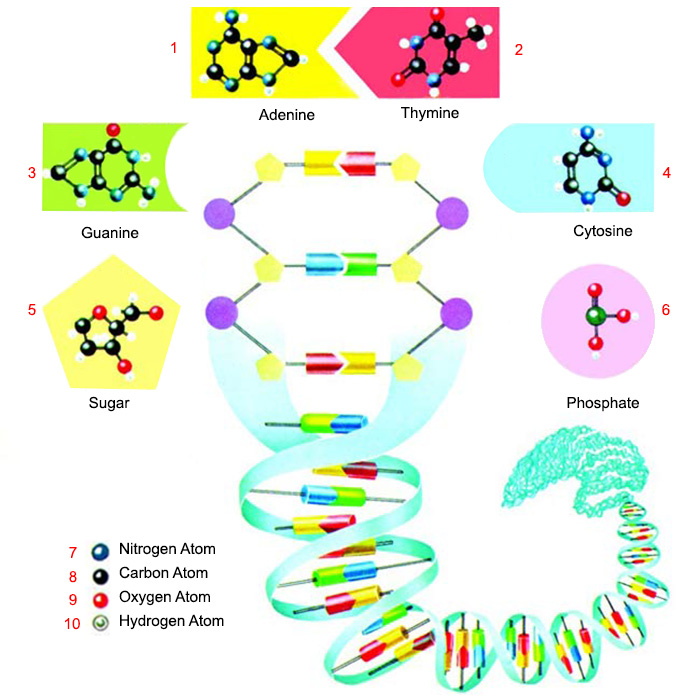 | |||
| 1. Adenine | 4. Cytosine | 7. Nitrogen atom, | 9. Oxygen atom, |
| The diagram to the side shows the structure of DNA, our bodies' data bank. Any DNA molecule consists of four different nucleotides set out consecutively in varying sequences. These molecules' sequence contains the code regarding the protein structures used by all living things. | |||
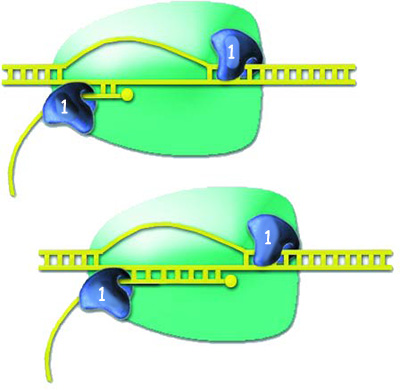 |
| 1. RNA polymerase Enzyme |
| When a protein is to be produced, the enzyme RNA polymerase selects and copies the necessary data from the DNA. What we refer to as an enzyme, a collection of atoms, displays consciousness in a truly miraculous way. |
Data regarding all of our bodies' functions is stored in the DNA molecule within the cell nucleus. When a protein is to be produced, the information regarding that protein is taken from DNA. However, the DNA must correctly understand the data concerning that protein and also provide the correct information. When chemists want to produce a compound, they make an oral or written request for all the raw materials they will need. Similarly, a special language is used in order to request a protein formula from DNA, in a language with an alphabet consisting of four letters.
The DNA molecule consists of four different nucleotides, set out in different sequences. These nucleotides are referred to by the initials of their base molecules; A (adenine), B (guanine), C (cytosine) and T (thiamin). The sequence of these molecules establishes the structures of all the proteins used by a living thing. The information in every human being's DNA about the proteins that determine his own characteristics—so much information that it could fill a library of encyclopedias—is written in a four-letter alphabet.
That enough information to fill hundreds of encyclopedias is encoded in a space smaller than 1,000th of a millimeter is truly extraordinary. Written out, this information would fill a thousand 500-page encyclopedias—nearly 20 times as long as the Encyclopedia Britannica.19 Computer chips have been modeled with very high data storage capacities, and high-cost research is being performed to increase that capacity with different coding systems. But the protein data in the DNA molecule has been encoded in a manner incomparably superior to any technology yet produced.20 Such flawless data storage could not have come into existence by chance.
For life to continue, processes inside the cell must not be disrupted, its needs must be accurately met, with the correct proteins being produced. Therefore, after the message is received concerning which protein needs to be produced, the correct information must be selected and taken from the DNA. But Who makes that selection?
This vitally important selection is not made by a scientist capable of seeing and hearing, with years of education followed by years of scientific experience, but by a molecule consisting of unconscious molecules. The enzyme RNA polymerase, another protein with a perfect structure, carries out this essential selection. This enzyme performs an exceptionally difficult job. First, it must select the requisite letters for the protein to be produced from among the 3 billion in the DNA molecule. The way that the polymerase enzyme extracts a few lines of information from inside the DNA molecule's 3 billion letters is analogous to quickly finding a few lines of information hidden in a 1,000-volume encyclopedia, but with no description of it.
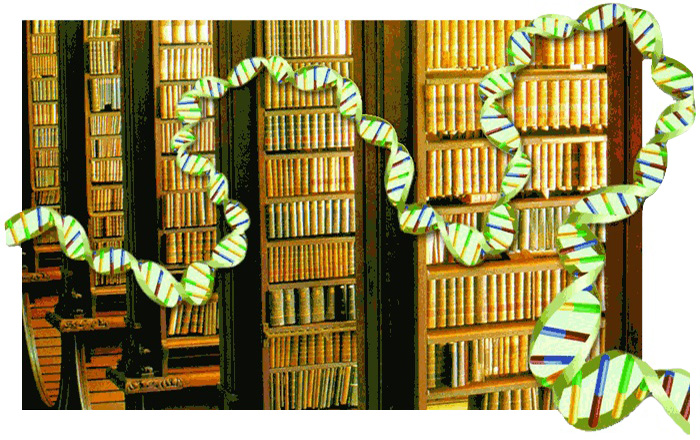 |
| The truly extraordinary data contained in DNA is equivalent to a 20-volume encyclopaedia condensed into an area of less than 1 nanometer, or 1 billionth of a meter. It is impossible for human to conceive of such a data-storage system, let alone manufacture one. Through computer technology, microchips have been manufactured to store data, but they have nowhere near the capacity of DNA. |
Including the worldwide Human Genome Project, hundreds of the world's most eminent scientists, in laboratories equipped with the most advanced technology have been working to read part of the information in human DNA. They have been able to read a large part of it, but have still not determined which letters are used for which protein or gene. Nonetheless, at every moment, trillions of RNA polymerase enzymes in the 100 trillion cells in your body are able to read the information in DNA from the beginning to the end and, moreover, to extract it in an error-free manner. This task requires competence, intelligence, information and research. What performs it at enormous speed is a molecule, a combination of unconscious atoms. Astonishingly, Darwinists claim that such a system came into being by coincidence, under the effects of lightning on primordial tide pools.
After the polymerase enzyme has found in the DNA molecule information regarding the protein to be produced, it must now exhibit another sign of consciousness and ability, by copying this information to the site of production.
 |
| Humans have been using the most advanced technology for years, but only managed to decipher DNA in 2000. Yet proteins invisible to the naked eye have been using DNA constantly, flawlessly for billions of years. |
Copying of Protein Data from DNA | |
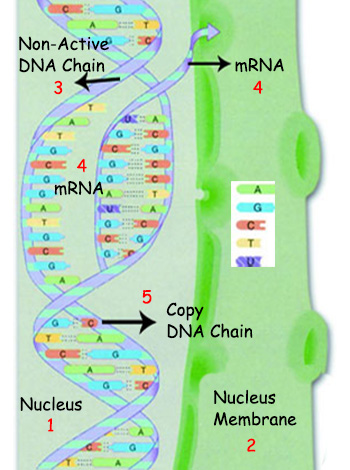 | |
| 1. Nucleus | 4. mRNA |
| A. Adenine | T. Thymine |
It is of the greatest importance that the information extracted from the DNA be copied accurately. All the information to be used during the course of producing the protein is read from that requisition, and the slightest error could have fatal consequences for the organism. For example, if only one of the 600 amino acids changes place in the protein hemoglobin. The hemoglobin will assume an entirely different defective structure and be unable to carry oxygen in the blood to the tissues. The fatal disease known as Mediterranean anemia is the result.
For the copying process to start, one major hurdle must be overcome. The strands of DNA twine around one another like a spiral staircase and must be separated before the copying process can begin. During this process, the RNA polymerase enzyme again goes into action. First the RNA polymerase binds to 35 letters from the beginning of the gene to be coded, and opens up the various stages of the DNA helix just like a zipper. This opening up takes place so very quickly that there is a danger of the DNA heating up because friction. Yet as a result of a system of finely regulated precautions, even this danger has been eliminated: A special enzyme attaches to the two ends of the opened DNA helix and prevents friction from taking place. Other special enzymes prevent the DNA rejoining again during opening.
Were it not for Allah’s miraculous creation of these enzymes, the order requisition known as messenger RNA could not be copied. Before the copying process began, the arms of the DNA spirals would wind around one another again, and friction would damage the DNA structure. As you have seen, dozens of proteins and enzymes are involved in every stage of the operation, and all perform their functions in the greatest harmony.
Never forget the agents involved, both enzymes and proteins, are unconscious molecules made up of specific quantities of atoms. By Allah’s will, every one of these molecules discharges its own functions in line with superior knowledge and a sense of responsibility.
After these special precautions are taken, a few more obstacles are still to be overcome. For one thing, information regarding the amino acid sequence of the protein to be produced may be located in any region of the long DNA molecule. What will the polymerase enzyme do to copy codes indicated in different areas of the amino acid string? It cannot tear the DNA apart and throw away the unwanted sections. If it continues along the same path, it will end up copying unwanted data and the desired protein will not form.
To resolve this difficulty, an extraordinarily conscious phenomenon now takes place. As if the DNA were aware that it had to assist the copying process, it bends and presents to the outside the region containing the unwanted information. In this way, codes that need to be read consecutively but which have other codes between them are able to come together from distant parts of the sequence. The codes to be copied thus form a single line, so that the polymerase enzyme can easily copy the order for the protein to be produced.
Faulty Copying Causes Cancer | |
Research into bladder cancer has revealed that proteins wrongly produced in a cell play a major role in cancer. Genes copied incorrectly during the DNA copying process lead to the production of incorrect proteins. Faulty copying in the single stage in a special 5,000-step gene in the DNA impair the entire cell. [Robert A. Weinberg, One Renegade Cell, How Cancer Begins, New York: Basic Books (1st Edition) 1998, p. 42] By using flawed data to produce proteins, these faulty genes damage the cell rather than benefiting it. |
To eliminate unwanted codes, a different method is sometimes employed. The RNA polymerase enzyme copies the entire gene from beginning to end, including the unnecessary codes. Then, spliceosome enzymes arrive to bend the unnecessary codes and eject them in ring form. To make this happen, these enzymes have to compare the prescription they carry with the information copied from the DNA and identify the unnecessary elements. Were you given two long lists of letters and asked to identify the superfluous ones among them, you would have to examine each list very carefully and check it against the other, line by line. For that reason, you should not be deceived by reading "it selects," "vends," or "ejects" in any biology textbook or documentary. What is actually doing the comparing, identifying, examining, distinguishing, selecting, bending and ejecting is unconscious substances, that consist of inanimate materials such as carbon, nitrogen and phosphate, under the command of Allah.
 | ||
| 1. Original DNA | 3. The component to be detached is identified. | 4. Detachment |
| The information determining any one protein may sometimes be found in different places in DNA. Enzymes known as sliceosomes then arrive and bend the chain in such a way that the two ends of the unwanted DNA region touch. This "loop" is removed and discarded. In order to do this, enzymes need to display enormous conscious brainpower. They must be careful to flawlessly identify and eliminate the appropriate genes from the millions in the helix. How a small molecule of unconscious atoms can display such intelligence shows the perfection of Almighty Allah's creation. | ||
This is by no means the end of the amazing and extraordinary events that take place during the copying of the order requisition from the DNA. The copying units also have to be halted, or else the polymerase enzyme will copy the gene from beginning to end. At the end of the protein encoding gene is a codon that indicates that its finish. (Every group of three nucleotides making up the code in DNA is known as a codon.) When the RNA polymerase comes to a codon, it understands that it has to cease copying and it separates from the DNA and messenger RNA carrying the necessary message for the protein. At this point, however, it still acts with the greatest care. The messenger RNA must leave the cell nucleus and travel an extremely long way until it reaches the ribosome where production will take place. In the process, the message it carries must come to no harm. Therefore, it emerges from the cell nucleus under the protection of certain special enzymes.
Once the necessary information for protein production has been found and copied from the cell's DNA, that information must now reach the ribosomes where the protein will be produced. These organelles, present in every cell, are rather a long distance from the DNA in the nucleus and are distributed throughout all the cytoplasm (the fluid in the cell). The production orders have to be rushed to these factories in a flawlessly accurate manner. Messenger RNA (mRNA) heads straight for the ribosome without losing its way among the many organelles and molecules in the cell. When it finds the ribosome, the mRNA settles in a line on its outer surface. In this way, information regarding the amino acid sequences of the protein to be manufactured reaches the production center in the correct form. The copied mRNA also carries information about what it must do to produce a protein, when the process needs to start and finish. Therefore, when this command reaches the ribosome, messages begin to be sent to other regions of the cell to bring to the ribosome those amino acids necessary for the protein's manufacture. 21
At this point in the production of protein, one of the miracles of perfect organization takes place.
After the RNA carrying the protein data reaches the ribosome, another form of RNA, transport RNA (or tRNA) enters the equation—a molecule specially produced according to information in the DNA. Since these RNAs are charged solely with transporting to the ribosomes those amino acids to be used as raw materials in the production of protein they are known as transporters. These RNAs are like forklifts carrying raw materials for production inside a factory. Yet in the delivery system of these RNAs, there is one very different property.
As already mentioned, there are 20 varieties of amino acids, or raw material, in every living cell. Each of these 20 amino acids is carried by a transporter peculiar to itself.22 The bonding of amino acids to the tRNA that will transport them takes place as a result of a series of complex processes. A special enzyme activates every variety of amino acid and also permits the amino acid to bond to the tRNA. This means that the enzyme (amino acid synthetase) must possess structures to let it attach to both the amino acid and to the tRNA.
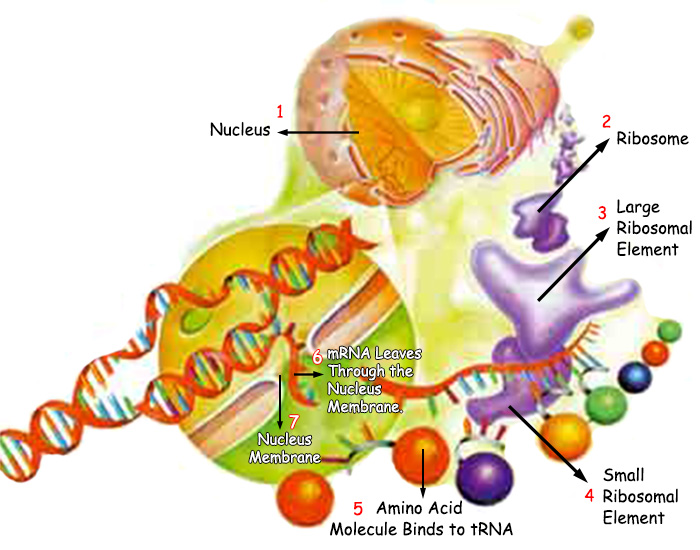 | |
| 1. Nucleus | 5. Amino acid molecule binds to tRNA |
| The information determining the protein to be produced leaves the cell nucleus with the mRNA and arrives at the ribosome, where manufacture will take place, in other words. At this point, the tRNAs begin bringing the necessary materials to the ribosome. | |
At every stage, as you have seen, there are many components with interconnected processes and functions. In the absence of just one of these, the ensuing damage will make survival impossible. For example, if these special enzymes did not exist to activate the amino acids and bind them to the tRNA, those amino acids needed for protein synthesis would not reach the ribosome. Therefore, the entire system must have been outlined beforehand and created together with the specifics of all the materials it requires.
Every amino acid that the tRNA brings to the ribosome must be processed in specific locations in the production line determined by the mRNA. Throughout the entire process, if even a single amino acid is processed in an incorrect unit, the protein molecule will become useless. Yet this process takes place in a flawless manner in all living cells. Every tRNA engaged in delivery carries its amino acid to the site specified in the production order, ensuring that the function is not disrupted. As you know, the production order is recorded in the mRNA. This behavior reveals the perfect conception of discipline, consciousness and responsibility in these unconscious molecules—a striking indication that each and every one has submitted to Allah, the Omniscient and Almighty, and acts under His control.
 |
| During protein synthesis, the alphabet making up the DNA needs to be translated into an alphabet that manufactures protein. For example, the writing at left must be translated into the "protein language" on the right. |
The requisition order—the information regarding the protein to be produced—and the raw materials are now ready. The order has been transmitted to all the machines along the production line, but another problem now needs to be resolved. The production data, or order, is written down in a special language in the DNA, and production must take place according to the information in this special language. However, the sequences of the amino acids to be used as raw materials are written in a different language.
We can express this problem in the following analogy. The written instruction in the "requisition docket" is the language of the code comprising the DNA, written in a special alphabet consisting of four letters. But since 20 varieties of amino acid make up the proteins, the language of the proteins to be produced is different, consisting of a 20-letter alphabet. In short, the production information from the DNA is not in a language the amino acids can understand. In order for them to understand which amino acid the DNA information refers to, the DNA language has to be translated into the requisition language.
The ribosome factory has been equipped with a mechanism that resolves this problem in the best way. A translation system between the two languages has been created in the ribosome "factory." This translation system, known as the codon-anticodon method, works just like an expert translator, in a manner far superior to the most advanced present-day computers, translating the special DNA language written in a four-letter alphabet into the protein language consisting of 20 letters. In this way, it expresses which amino acids are to be placed alongside one another, and eventually the desired protein emerges in its correct form. The perfection in this translation process, whose details we shall examine in due course, is most noteworthy. There can be room for only one or two errors in the production of proteins essential for the life of the cell. No manmade technology can translate and write down the equivalent of 2,000 novels in such an error-free and flawless manner. 23
Through this method, the translation system permits amino acids to join together and work without any mistakes. The mRNA that first transports and installs the order information in the combining center in the ribosome comes together with the tRNA that carries amino acid on one of its ends. Every three letters in the mRNA are regarded as a codon, or a lock. The tRNA's three-dimensional structure resembles a plus sign and is bound to the amino acid being carried on its upper end. An anticodon—a key able to open the tRNA lock—moves opposite it. Through this special translation system used by the ribosome, proteins are produced in a flawless chain.
So that it can work in the best way together with this translation system, helper molecules on the ribosome's surface work together in complete coordination. These molecules are special RNAs sent to the production center and proteins, most of them specialized.24 The most important of these is ribosomal RNA, which lets information brought to the ribosome by the messenger RNA to be understood and read in a different language. During the error-free translation process, each one of these prepared mechanisms works in a flawless manner for the correct protein to emerge.
 | |
| 1. Site of binding to amino acid | 3. Anticodon |
| For the DNA language to turn into protein information, mRNA and tRNA come together like a lock and key. Every three letters in the mRNA are analogous to a lock. The bottom of the tRNA that serves as the key to open it moves exactly opposite this "lock." | |
During production, doubtless the most important process is the flawless combining of amino acids. We may summarize the events that take place during this combination process thus:
During the combining process, these events do not need to occur at specific time intervals, though all the processes take place at a great speed. In general, for example, the mRNA thread continues copying the order while its other end is still attached to the DNA, continuing the translation process from the other end.25 Indeed, a single mRNA thread can attach to several ribosomes or "factories" from different points to begin production, and can continue to place the order. In the same way, the mRNA can copy orders for proteins in more than one region of the DNA at the same time.26 Performing this exceedingly complex multi-stage process in several places simultaneously without a single mistake calls for enormous care and competence. How many tasks can a rational, conscious human handle at the same time? How many products can he supervise at once? Answer these questions, and you can more clearly understand the abilities possessed by a mRNA molecule.
Now, could this process have come into being by chance? Could millions of unconscious atoms have planned a system requiring such intelligence, identified the chance of natural events they needed to take place and then have waited for these circumstances to occur? Even if all the atoms in the universe were brought together, no matter what physical and chemical processes this assemblage collection was subjected to, still atoms devoid of consciousness, information and will could not have come up with such a system.
Furthermore, that organization does not end there. Once protein production has been carried out, the final step is to check whether the ordering and other features of the emerging amino acid chain are those of the desired protein.
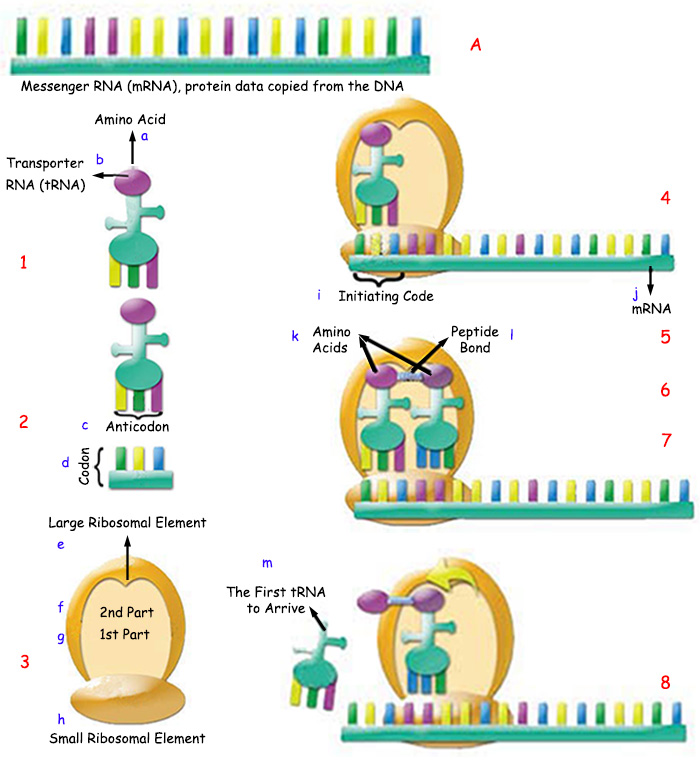 | |||
| a. Amino Acid | e. Large Ribosomal Element | h. Small Ribosomal Element | k. Amino Acids |
| A. Messenger RNA (mRNA), protein data copied from the DNA) 1.The messenger RNA carrying the production information first comes to the ribosome where the amino acids will be combined. Then the transport RNAs carrying the "raw materials" of amino acid come to the region. 2.Because of the codon-anticodon method, the translation system lets the combination process to be performed without error. Under this method, the messenger RNA and the transport RNA carrying the amino acid at one end come together like a lock and key. Every three letters in the messenger RNA are regarded as a codon, or lock. The end of the transport RNA, the anticodon capable of opening this lock, moves opposite it just like a key. 3.Where the messenger RNA and transport RNA line up opposite each other, ribosomal RNA goes into action. There are two special compartments in ribosomal RNA. The messenger RNA attaches to the smaller section, and the transport RNA to the larger one. Also, a special mechanism allows the tRNA and mRNA to harmonize in the region where they will bind, so they can easily assume their places. Most importantly, this indicates that when the ribosome was first created, an Intelligence knew the properties of mRNA and tRNA, knew that they would use the ribosome for a specific purpose, and created the appropriate compartments in the ribosome. They display a compatibility that cannot possibly have come about gradually and by chance. In addition, this detailed organization and fine calculations go even further. In the region where the tRNA will attach, there are two special compartments. The tRNA newly arrived at the ribosome uses the first one, and the other is used by tRNA that now departs the ribosome, having done its job. 4. In order for the translation process to begin, the first amino acid of the desired protein is brought by the tRNA opposite a special codon, known as the initiating codon, on the order requisition. The ribosome cannot start production before it receives information in this first codon about the protein to be manufactured. For all proteins, the initiating codon is the same: methionine. 26 5. Once the combining center has recognized this initiating codon, the codons (the order requisitions) that are determined for each protein start to be read, that is to say translated, one after the other. 6.First, the initiating codon attaches to the small compartment in the ribosomal RNA—the translation unit—which then goes into action by passing over this codon carrying the orde r information on to the mRNA. 7. At the same time, the tRNA assumes its place in the ribosome, together with the anticodon code written on it and the amino acid it carried. The amino acid (whose job is done) and the amino acid newly arriving to the ribosome is attached by means of a peptide bond. 8.Later, the tRNA that arrived first departs the ribosome. The second tRNA, with two amino acids attached, moves from the first compartment to the second. | |||
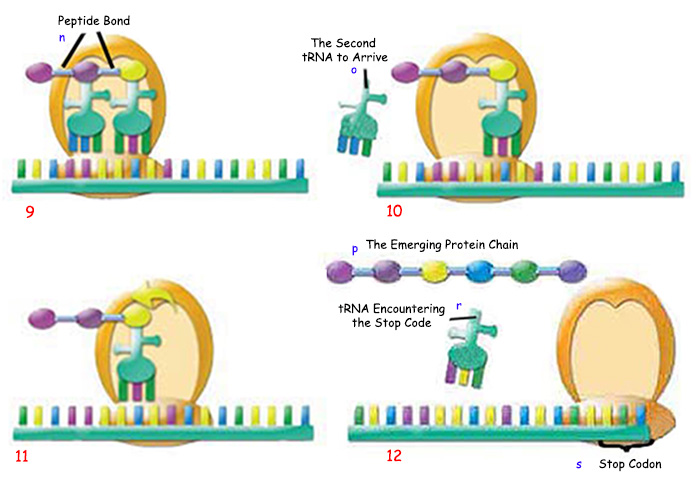 | |||
| n. Peptide Bond | o. The Second tRNA to Arrive | r. tRNA Encountering the Stop Code | |
| 9.The next tRNA arriving at the ribosome attaches to the first compartment, to which the tRNAs attach. The amino acids of the first and second tRNAs attach to the amino acid of this third tRNA. 10. Once this binding process has taken place, the second tRNA departs the ribosome. 11. At the same time, the third tRNA in the first compartment moves to the second compartment with the three amino acids attached to it. The ribosomal continues these processes along on the mRNA thread. 12.When the ribosomal RNA recognizes the halting codon on the mRNA, this process comes to an end. | |||
As you now know, the slightest error in the needed proteins leads to many dysfunctional mechanisms in the cell. The cell is unable to survive and in many such cases, this leads to serious illnesses. Many diseases are genetic in origin, arising from errors in one or more of these protein-synthesizing phases. However, as if they were consciously aware of these processes' importance, the cells behave with great care and check the proteins over and over again at various stages during synthesis. 27
During the production of a single protein, the necessary quality control is carried out by several proteins. These enzymes are just like the quality-control department in a factory: Each enzyme must possess detailed information about the protein under construction and be aware of every stage of the production process, or it cannot satisfactorily check the emerging result. The interesting fact, however, is that proteins themselves—with no free will of their own—perform these quality control-checks. These molecules have no knowledge or means of recognition. Indeed, they themselves can exist only if the system is functioning in an ordered manner. How can proteins consisting of unconscious atoms carry out this control process? Answers to these questions are plain to see. Each atom behaves according to the form and structure created for it by Allah.
After all these control checks are completed, the proteins are ready for use and will head straight for wherever they're to be employed. These valuable protein molecules must be transported to that location without suffering any damage. But how?
The answer to that question has not yet been fully understood. From what is known so far, this process is astonishingly complex.28
If proteins produced inside the cell were deposited where they are made, all that constant production would go to waste. However, just as in all other living systems, there is a flawless perfection in the transport of proteins. As a result, every new protein produced is carried by a special means to where it will either be used or else stored for later use. For example, different varieties of proteins—those to be dispatched outside the cell, those to be used in the mitochondria (the organelles responsible for producing energy), and those to be used in the nucleus—are all carried to their destinations by different mechanisms and routes known as protein targeting systems.29
These system's knowledge of which protein is to go where is a miracle all by itself. The determination of the means of transport according to the destination, packaging, and the support from enzymes to keep the protein from damage en route—all are feats that create utter amazement.
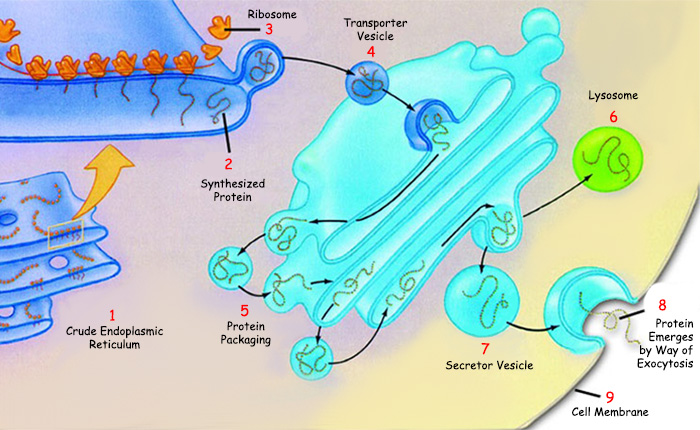 | |
| 1. Crude endoplasmic reticulum | 6. Lysosome |
| After the protein has been manufactured, intense activity continues inside the cell. The protein is either removed from the cell by a special transporter and is sent to where it will be used in the body, or else is deposited in the Golgi bodies, to be stored until needed. | |
The Nobel Prize winners Günter Blobel and George Palade spent many years researching this subject. They were amazed to discover that the newly produced proteins use a special amino acid sequence to be able to reach their destinations, and that once they do so, they separate from this so-called signal sequence.30 The protein setting out with the aid of this signal needs a great deal of help on its journey. Inside the cell, many newly produced proteins encounter molecular mechanisms, some of which hold on to the protein and transport it where it needs to go. Endoplasmic reticulum and Golgi bodies are examples of the important organelles that direct the protein where it has to go. For example, after the protein garbageaseis manufactured, it travels a distance of about one ten-thousandth of an inch (0.00025 of a centimeter). On this journey from the cytoplasm to the lysosome, dozens of different proteins are needed to ensure its security.31
While you sit reading this book, how busy are all the cells in your body performing all these tasks! You feel no movement, even though trillions of cells in your body carry out this production, each one using hundreds of mechanisms.
Moreover, this entire production, whose general lines have taken many pages to describe, occurs in only 10 seconds, or two minutes at most. And remember, this system operates within an area too small to be seen with the naked eye. Darwinist scientists who claim, in the face of the fact of creation, that the proteins that enable life came into being by chance, know that in fact, the concept of chance cannot explain such vast complexity.
The evolutionist biologist Professor Muammer Bilge describes the Darwinist despair in the face of this system that works too perfectly as to leave any room for chance:
We may say that the protein synthesis industry is carried out with an organizational perfection and flawless foresight inside the cell, which is able to produce these outcomes when necessary, creates no danger or damage to itself, and never goes down a one-way street. ... Everything in the cell happens like this. But how is it managed? How is it achieved? We are still unable to understand. We merely see the results and have only been able to distinguish a few points of this perfect organization that yields them.32
In the face of the extraordinary systems they encounter during their observations and research, Darwinist scientists invariably employ similar expressions, such as "a flawless foresight" or "organizational perfection." Yet their own theory cannot account for this flawlessness and perfection. They themselves are well aware of this, which is why they express their despair by saying they are "still unable to understand" how these extraordinary events take place. Clearly, however, unconscious atoms themselves cannot set up and maintain such a perfect organization. Every atom behaves under the inspiration, intellect and might of Allah.
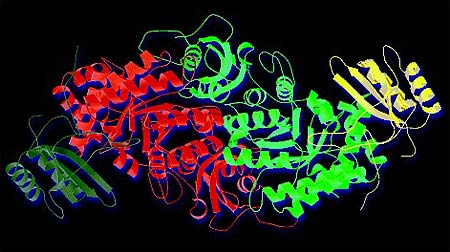 |
| Three-dimensional view of a protein |
The manufacture of a single protein molecule requires hundreds of different proteins and enzymes. In addition to these, many molecules and ions stand ready and waiting. That being so, how could the very first protein have come into being?
This is one of the most crucial impasses facing Darwinists, as the biologist Carly P. Haskings described in an article in American Scientist:
... But the most sweeping evolutionary questions at the level of biochemical genetics are still unanswered. How the genetic code first appeared and then evolved and, earlier even than that, how life itself originated on earth remain for the future to resolve... The fact that in all organisms living today, the processes both of replication of the DNA and of the effective translation of its code require highly precise enzymes and that, at the same time the molecular structures of those same enzymes are precisely specified by the DNA itself, poses a remarkable evolutionary mystery... Did the code and the means of translating it appear simultaneously in evolution? It seems almost incredible that any such coincidence could have occurred, given the extraordinary complexities of both sides and the requirement that they be coordinated accurately for survival. By a pre-Darwinian (or a skeptic of evolution after Darwin), this puzzle would surely have been interpreted as the most powerful sort of evidence for special creation. 33
As this scientist states, for protein synthesis to come about, all the systems inside the cell have to exist simultaneously. In the absence of just one component in this system, proteins cannot be produced, and life cannot continue. But as Haskings admits, in the absence of one component, the others clearly cannot form at all.
Allah has created all living things together with all their systems. He reveals His flawless creation in the Qur'an as thus:
He is Allah—the Creator, the Maker, the Giver of Form. To Him belong the Most Beautiful Names. Everything in the heavens and Earth glorifies Him. He is the Almighty, the All-Wise.
(Surat al-Hashr: 24)
17.Albert Lehninger L., Late University Professor of Medical Sciences, The Johns Hopkins University; David L. Nelson, Professor of Biochemistry, University of Wisconsin, Madison; Michael M. Cox, Professor of Biochemistry, University of Wisconsin, Madison; Principles of Biochemistry (Second Edition), New York:Worth Publishers, p. 892. 
19.Aaldert Mennega, "Reflections on The Scientific Method," Creation Research Society Quarterly, June 1972, p. 36. 
20.Werner Gitt, In The Beginning Was Information, Christliche Literatur- Verbreitung e.
5. , CLV Bielefeld Germany, 1997, pp. 95-96. 
21."Cell's Energy Use High for Protein Synthesis," Chemical & Engineering News, August, 20, 1979, p. 6. 
22.Albert Lehninger L., David L. Nelson, Michael M. Cox, Principles of Biochemistry, Fourth Edition, New York: W. H. Freeman and Company, p. 1035. 
23.Mahlon B .Hoagland, The Roots of Life, Boston: Houghton Mifflin, 1978, p. 24. 
24.Albert Lehninger L., David L. Nelson, Michael M. Cox, Principles of Biochemistry, p. 1054. 
25.Curtis Barnes, Invitation to Biology, p. 191. 
27."Cell's Energy Use High for Protein Synthesis," Chemical & Engineering News, August 20, 1979, p. 6. 
28.Albert Lehninger L., David L. Nelson, Michael M. Cox, Principles of Biochemistry, p. 1068. 
31.Michael Behe, Darwin's Black Box, p. 108. 
32. Prof. Dr. Muammer Bilge, Cell Science, Cerrahpasa Medical Faculty, Chairs of Physiology and Biophysics (3rd Edition), pp. 131-132. 
33.Caryl P. Haskins, "Advances and Challenges in Science in 1970," American Scientist, May 1971, p. 305. 